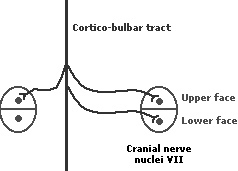A myelinated pathway originating in the motor cortex of the frontal lobe and terminating in the brain stem. The tract descends through the genu (or bend) of the internal capsule. The axons exit at the appropriate level of brain stem to synapse on the so-called lower motor neurons of the cranial nerves in the brain stem motor nuclei. These include cranial nerve nuclei 5, 7, and 12, and the nucleus ambiguous (involved in regulation of heart rate and arterial pressure). Innervation by the CBT is mainly bilateral, with an exception the cranial nerve nuclei VII (CBT innervation of the cranial nerve nuclei VII is bilateral for the upper face motor neurons, but exclusively contralateral for the motor neurons of the lower face. See figure below). The muscles of the face, head and neck are innervated by the CBT, in contrast to the corticospinal tract that connects the motor cortex to spinal motor neurons, and thereby controls movement of the torso, upper and lower limbs. Nearly all cranial nerves receive bilateral innervation from the fibers of the pyramidal tract, with the result that both left and right members of a pair of cranial nerves are innervated by the motor areas of both the left and right hemispheres. Such redundancy acts a safety mechanism: should there be a unilateral lesion of the pyramidal tract, then both sides of areas connected to cranial nerves will continue to receive inputs from the cortex. As a consequence, paralysis is prevented, but muscles involved in chewing, swallowing, breathing, and speaking become weak (something known as pseudobulbar palsy). Developmentally, corticospinal and corticobulbar tracts are only beginning their myelination cycle in late gestation and it is not complete until two years of age. However, myelination of the CBT occurs earlier, namely, between 24 and 28 weeks gestation. Functionally this makes sense as it allows the human fetus time to exercise sucking patterns in that ensures ingestion of milk after birth by the (full term) newborn. The ‘bulb’ refers to the medulla oblongata in the brainstem (and sometimes includes the pons).
